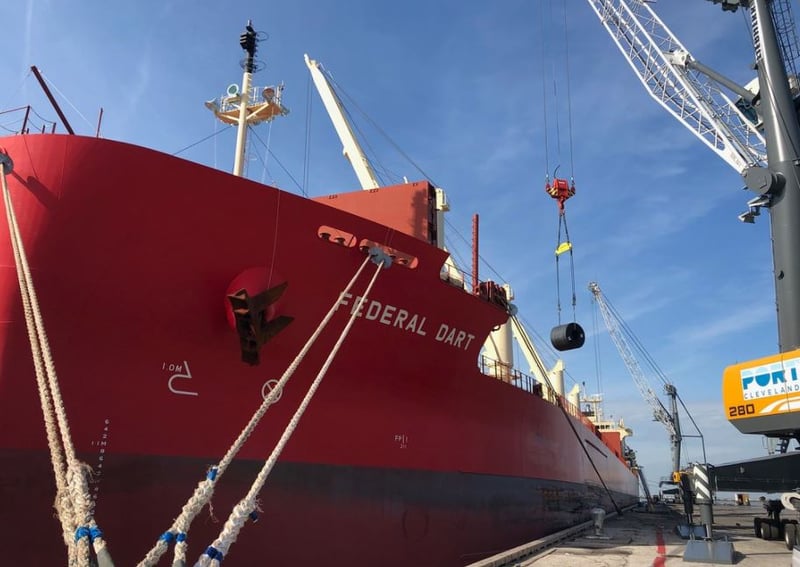 Credit: Chamber of Marine Commerce
Credit: Chamber of Marine Commerce Great Lakes-St. Lawrence shipping 2022 government wish list
The Chamber of Marine Commerce today unveiled a 2022 wish list for legislative and policymakers to work in partnership with industry to ensure the Great Lakes-St. Lawrence River transportation corridor remains a resilient supply chain and at the forefront of marine innovation to meet ambitious goals of reaching net-zero carbon emissions by 2050.
The policy wish list comes as the St. Lawrence Seaway, a key segment of the inland navigation waterway, announces that cargo shipments (between March 22 and Jan. 10) totaled in excess of 38 million metric tons, an estimated 1% above the previous season. Many of the worst-hit cargo sectors in the 2020 navigation season — iron ore, aluminum, and steel — bounced back and some even surpassed 2019 levels. Shipments of construction materials were booming as the Canadian and the U.S. economies recovered and began “building back better”. Slower grain exports due to smaller harvests compared to 2020 continued to offset the growth in other cargo sectors. Without grain factored in, estimated overall tonnage numbers would be up almost 13%.
Bruce Burrows, President and CEO of the CMC, said: “Throughout the pandemic and amidst global supply chain disruptions, Great Lakes-St. Lawrence shipping once again proved it’s a reliable, ‘safe harbor’ in a storm. Our members not only delivered for their traditional bulk customers without delays, but some also cultivated new business opportunities by broadening their services for container shipments between cities and to overseas destinations. Our ports and their customers continued renewing, improving and expanding both their infrastructure and their business offerings.”
“But we can’t be complacent. The economic and social repercussions that we’ve seen from bottlenecks and severe weather events in other parts of North America this past year reinforces how important it is for governments to work alongside industry to innovate and invest in economically-smart transportation solutions that boost supply chain resiliency and help reduce the future impacts of climate change.”
Policy and regulatory priorities for 2022
- Decarbonization: CMC members are looking to partner with the Canadian federal government, as well as with research facilities, to develop the future of transportation here in Canada to meet GHG-reduction goals. The marine sector will explore the potential for a multi-stakeholder initiative to establish a new and innovative Green Shipping Corridor in Canada, incorporating a trial of the best of Canadian shipping that is already the most fuel-efficient and carbon-friendly way to move goods, and an important part of the solution to address climate change. Domestic marine navigation (including cargo, passengers, and fishing) contributes less than 1% of all GHG emissions in Canada. Through fleet renewal and the use of alternative fuels, CMC members’ Canadian commercial fleets have already decreased carbon emissions by 19% between 2008 and 2017. However, ships and ports will require support and investment to expand the use of transition fuels, such as LNG and biofuels, as well as develop new propulsion technologies to propel marine innovation even further to meet GHG-reduction targets of net-zero carbon emissions by 2050. To make these pieces all work, CMC will be advocating for a “Made in Canada” approach to Canadian regulations for reducing carbon emissions from domestic ships that account for our short sea shipping trading patterns and unique Canadian ship designs.
- Supply Chain resiliency: CMC is advocating that the U.S. and Canadian governments ensure that water level management leads to safe and continued navigation on the Great Lakes-St. Lawrence Seaway System and that two industry representatives (one CDN, one U.S.) be appointed on the International Lake Ontario-St. Lawrence River Board (ILOSLRB) to ensure that infrastructure ownership and commercial users are part of the decision-making process for outflow levels through the Moses-Saunders dam.
In 2020, the St. Lawrence Seaway navigation season through the Montreal-Lake Ontario section was delayed by 12 days to accommodate outflows of water through the Moses-Saunders dam that were unsafe for navigation. The increased outflow, decided by the ILOSLRB to prevent potential flooding on Lake Ontario, had little effect on Lake levels but impacted more than $80 million worth of shipping business. The latest economic study of impacts is based on the cost to the economy of shipping interruptions.
Furthermore, recent experience with flooding in B.C. demonstrates that climate change means weather events will be more extreme and various levels of government along with industry must now work together to develop a much broader, holistic climate resiliency plan that looks at every avenue including flood zoning, shoreline resiliency and infrastructure investments for residents and business owners.
- Port and Waterway Infrastructure: The CMC is advocating on both sides of the border to secure funding from economic stimulus measures for port and waterway infrastructure to increase trade growth but also for climate change resiliency against persistent high waters throughout the Great Lakes.
- Pilotage Reform: With global inflation and the exponential costs of installing ballast water treatment systems over the coming years – it will be more important than ever to ensure that Canadian government-mandated pilotage services take into account today’s technology, making more effective use of risk assessments and improve efficiency and cost-effectiveness.









